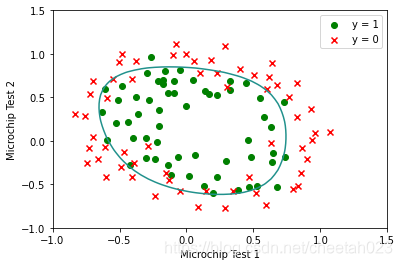# -*- coding: utf-8 -*-
"""
Created on Wed Jul 1 00:20:53 2020
@author: cheetah023
"""
import numpy as np
import matplotlib.pyplot as plt
import scipy.optimize as opt
#函数定义
def sigmoid(X):
return 1 /(1 + np.exp(-X))
def mapFeature(x1, x2):
degree = 6
if type(x1) is np.float64:
out = np.ones([1,1])
else:
out = np.ones([x1.shape[0],1])
for i in range(1,degree+1):
for j in range(0,i+1):
new_column = (x1 ** (i-j)) * (x2 ** j)
out = np.column_stack([out,new_column])
return out
def costFunction(theta, X, y, lamda):
theta = np.reshape(theta,(X.shape[1],1))
sig = sigmoid(np.dot(X,theta))
m = X.shape[0]
#不能用theta[0]=0来算,会出错
#theta[0] = 0
cost = (np.dot(-y.T,np.log(sig)) - np.dot(1-y.T,np.log(1-sig))) / m
cost = cost + np.dot(theta.T[0,1:],theta[1:,0]) * lamda / (2 * m)
return cost
def gradient(theta, X, y, lamda):
theta = np.reshape(theta,(X.shape[1],1))
m = X.shape[0]
sig = sigmoid(np.dot(X,theta))
#这里不reshape的话,执行opt.minimize
#会报错ValueError: tnc: invalid gradient vector from minimized function.
#sig = np.reshape(sig,(m,1))
theta[0] = 0
grad = np.zeros([X.shape[1],1])
grad = np.dot(X.T,(sig - y)) / m
grad = grad + theta * lamda / m
return grad
def plotDecisionBoundary(theta, X, y):
(m,n) = X.shape
if n <= 3:
x1_min = np.min(X[:,1])
x1_max = np.max(X[:,1])
x1 = np.arange(x1_min, x1_max,0.5)
x2 = -(theta[0] + theta[1] * x1) / theta[2]
plt.plot(x1,x2,'-')
else:
x1 = np.linspace(-1, 1.5, 50)
x2 = np.linspace(-1, 1.5, 50)
Z = np.zeros([x1.shape[0],x2.shape[0]])
for i in range(0,len(x1)):
for j in range(0,len(x2)):
Z[i,j] = mapFeature(x1[i],x2[j]).dot(theta)
Z = Z.T
plt.contour(x1,x2,Z,0)
def plotdata(X, y):
postive = np.where(y > 0.5)
negtive = np.where(y < 0.5)
#postive和negtive包含两个元组,取第一个元组postive[0]和negtive[0]
plt.scatter(X[postive[0],0],X[postive[0],1],marker='o',c='g')
plt.scatter(X[negtive[0],0],X[negtive[0],1],marker='x',c='r')
#Part 1: Regularized Logistic Regression
data = np.loadtxt('ex2data2.txt',delimiter=',')
X = data[:,0:2]
y = data[:,2:3]
print('X:',X.shape)
print('y:',y.shape)
plotdata(X, y)
plt.xlabel('Microchip Test 1')
plt.ylabel('Microchip Test 2')
plt.legend(['y = 1', 'y = 0'])
X = mapFeature(X[:,0], X[:,1])
(m,n) = X.shape
print('m:',m,'n:',n)
initial_theta = np.zeros([n,1])
lamda = 1
cost = costFunction(initial_theta, X, y, lamda)
grad = gradient(initial_theta, X, y, lamda)
print('Cost at initial theta (zeros):',cost)
print('Expected cost (approx): 0.693')
print('Gradient at initial theta (zeros) - first five values only:')
print(grad[0:5])
print('Expected gradients (approx) - first five values only:')
print('0.0085\n 0.0188\n 0.0001\n 0.0503\n 0.0115')
lamda = 10
test_theta = np.ones([n,1])
cost = costFunction(test_theta, X, y, lamda)
grad = gradient(test_theta, X, y, lamda)
print('Cost at test theta (with lambda = 10):',cost)
print('Expected cost (approx): 3.16')
print('Gradient at test theta - first five values only:')
print(grad[0:5])
print('Expected gradients (approx) - first five values only:')
print('0.3460\n 0.1614\n 0.1948\n 0.2269\n 0.0922')
#Part 2: Regularization and Accuracies
initial_theta = np.zeros([n,1])
lamda = 1;
result = opt.minimize(fun=costFunction,
x0=initial_theta,
args=(X,y,lamda),
method='TNC',
jac=gradient)
theta = result.x
cost = result.fun
plotDecisionBoundary(theta, X, y)
plt.legend(['y = 1', 'y = 0'])
#Compute accuracy on our training set
H = sigmoid(np.dot(X,theta))
index = np.where(H>=0.5)
p = np.zeros([m,1])
p[index] = 1
prob = np.mean(p == y) * 100
print('Train Accuracy:',prob)
print('Expected accuracy (with lambda = 1): 83.1 (approx)')
运行结果:
X: (100, 2)
y: (100, 1)
Cost at initial theta (zeros): [[0.69314718]]
Expected cost (approx): 0.693
Gradient at initial theta (zeros):
[[ -0.1 ]
[-12.00921659]
[-11.26284221]]
Expected gradients (approx):
-0.1000
-12.0092
-11.2628
Cost at test theta: [[0.21833019]]
Expected cost (approx): 0.218
Gradient at test theta:
[[0.04290299]
[2.56623412]
[2.64679737]]
Expected gradients (approx):
0.043
2.566
2.647
Cost at theta found by fminunc: [[0.2034977]]
Expected cost (approx): 0.203
theta: [-25.16131857 0.20623159 0.20147149]
Expected theta (approx):
-25.161
0.206
0.201
For a student with scores 45 and 85, we predict an admission
probability of 0.7762906213164001
Train Accuracy: 89.0
Expected accuracy (approx): 89.0
runfile('H:/course/Machine_Learning_Andrew_ng/python_ex2/ex2_reg.py', wdir='H:/course/Machine_Learning_Andrew_ng/python_ex2')
X: (118, 2)
y: (118, 1)
m: 118 n: 28
Cost at initial theta (zeros): [[0.69314718]]
Expected cost (approx): 0.693
Gradient at initial theta (zeros) - first five values only:
[[8.47457627e-03]
[1.87880932e-02]
[7.77711864e-05]
[5.03446395e-02]
[1.15013308e-02]]
Expected gradients (approx) - first five values only:
0.0085
0.0188
0.0001
0.0503
0.0115
Cost at test theta (with lambda = 10): [[3.16450933]]
Expected cost (approx): 3.16
Gradient at test theta - first five values only:
[[0.34604507]
[0.16135192]
[0.19479576]
[0.22686278]
[0.09218568]]
Expected gradients (approx) - first five values only:
0.3460
0.1614
0.1948
0.2269
0.0922
Train Accuracy: 83.05084745762711
Expected accuracy (with lambda = 1): 83.1 (approx)

参考资料:
https://blog.csdn.net/lccflccf/category_8379707.html
https://blog.csdn.net/Cowry5/article/details/83302646
https://blog.csdn.net/weixin_44027820/category_9754493.html
总结:
1、画边界线花的时间最多,主要还是不熟导致






















 362
362











 被折叠的 条评论
为什么被折叠?
被折叠的 条评论
为什么被折叠?








